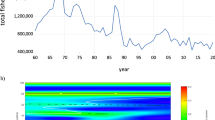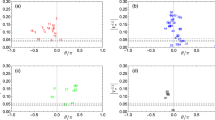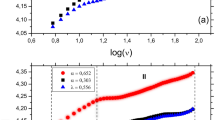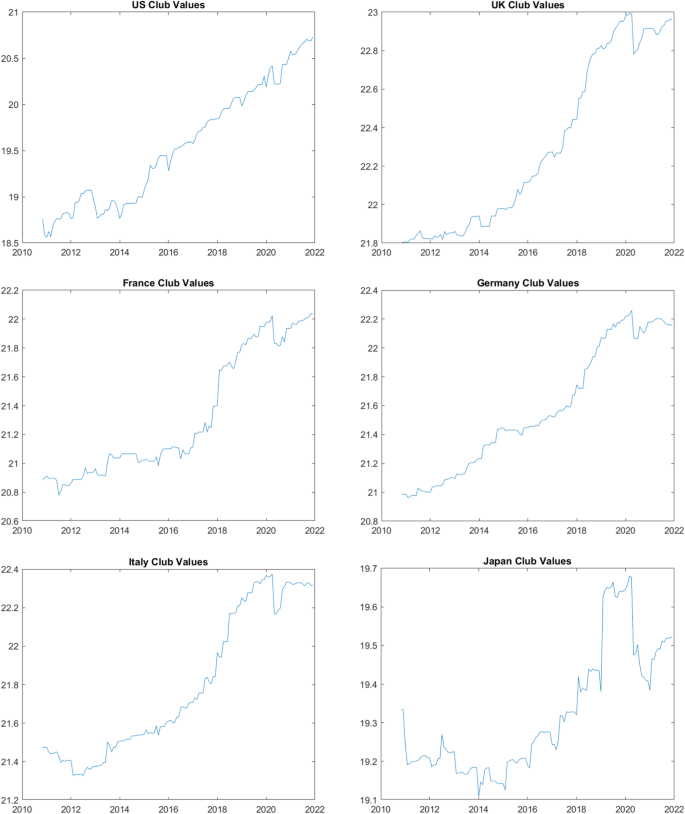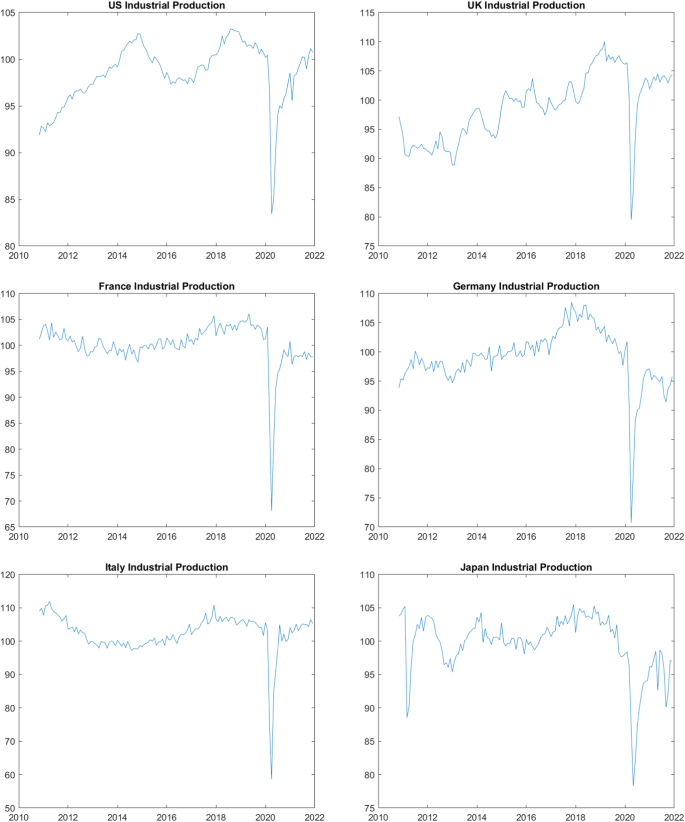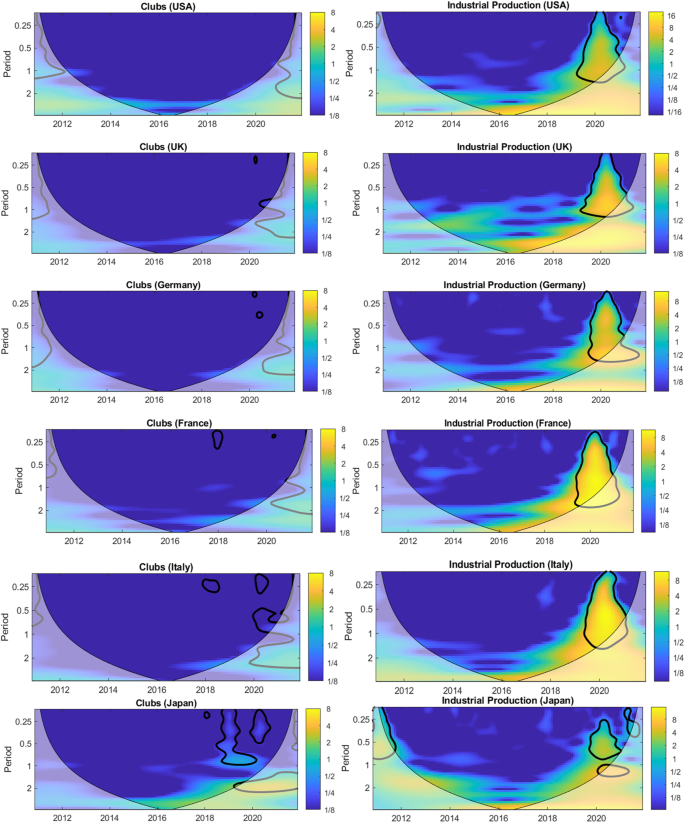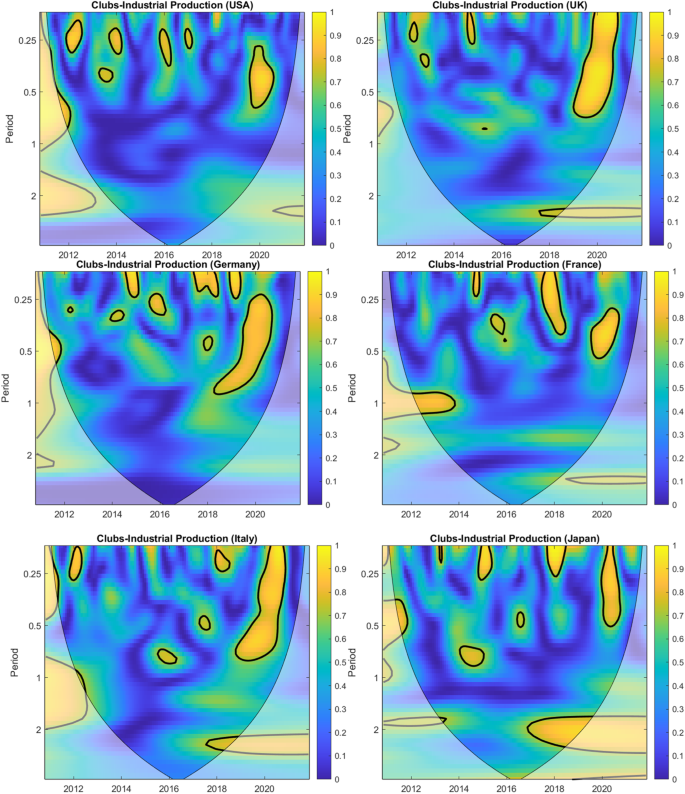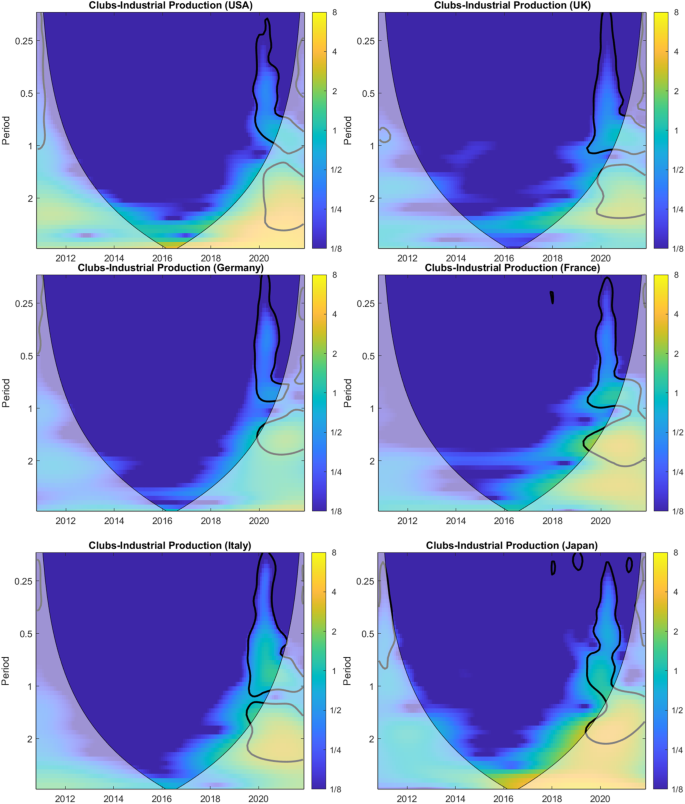Abstract
It is believed that societies use sports as a tool for their social and cultural development. In particular, developed countries have embraced sports as part of their lives and have ranked it as a source of economic growth. The increase in sports consumption and industries can contribute to economic growth, and economic growth can have a positive impact on sports industries vice versa. The wavelet methodology is a way to discover the relationship between sports and economic growth by examining frequency and time domain aspects and identifying shorter to longer-term relationships continuously. The industrial production of different countries has experienced short and medium-term cycles around the year 2020. In contrast, the values of football clubs in these countries have shown minimal fluctuations, despite the emergence of some areas with slight significance. The cross wavelet analysis asserted the significance relation revealed after the covid 19 restrictions, both in shorter and longer periods. The wavelet coherence analysis showed that co-movement was observed in short-term cycles in countries across the periods while long-term co-movements are observed only in only in small areas or generally out of cone of influence.
Similar content being viewed by others
Introduction
While the field of economics emphasizes the efficient allocation of scarce resources for profit and benefit (Cypher and Dietz 1997; Todara and Smith 2012), the concept of economic growth is closely linked to social welfare and services (Dumciuviene 2015). In the context of developing countries, adopting an international perspective is essential, rather than relying solely on traditional economic approaches (Todara and Smith 2012). The acquisition of an international perspective is a crucial requirement for achieving economic growth.
Studies on economic growth and development consistently address contemporary issues such as global poverty, unemployment, and sustainability, necessitating a comprehensive examination of the economy (Nunn 2020). Research reveals a clear interrelationship between economic growth and various sectors, including tourism, industry, environment, entertainment, health, and sports. Among these fields, sports exemplify the pronounced effects of economic growth, contributing not only to economic aspects but also to individual personal growth and societal development.
In contemporary society, both ordinary individuals and influential figures in politics and culture recognize the value of sports as a phenomenon with unique functions in personal improvement and its socio-economic consequences (Razvan et al. 2020). While modern sports help address certain social issues (Savizn et al. 2017), they are also recognized as an important economic sector that establishes new standards (Gratton 1998). Initially seen as a means to boost sales, the sports industry is intimately connected to economic growth (Kellett and Russell 2009; Kokolakakisn et al. 2019), particularly in developed countries (He 2018). Remarkable developments have occurred in the sports industry over the past two decades due to the increased affinity for sports (Gratton and Solbery 2007). In 2015, the sports industry accounted for approximately 3% of global economic activities (Manoli 2018). The industry encompasses mega sports events (e.g., the Olympic Games, world championships, and special international tournaments), media, sponsorship, volunteering, sports equipment, and sports tourism. Sports events, in particular, play a significant role in economic development and sustainability.
While economic growth can influence the sports industry, the growth of sports consumption can also become a new source of economic growth (Kharchenko and Ziming 2021). There are various reasons for the rise of economic growth, and the expansion of industries due to increased sports consumption can contribute to this growth (Qiun et al. 2013). Although Kobierecki and Pierzgalski (2022) found no significant effect of mega sports events on economic growth, many countries still desire to host such events due to their potential contribution to the economy.
Football has become a significant investment for many countries worldwide, with the aim of increasing their domestic sports market volume and enhancing international connections (Zhang et al. 2018). As a result, sporting events have gained more attention than ever before, and investments have increased alongside this growing interest. While high-level events like the FIFA World Cup and the Olympic Games require billions of dollars for infrastructure, small-level events require national support (Giampiccolin et al. 2015; Nauright, 2004). Investments in sports infrastructure, including technical, architectural, and superstructure works, are necessary for sports development in cities.
Economic growth is a fundamental prerequisite for combating sportive underdevelopment (Andreff 2001). Professional football clubs focus on two goals: success in business performance and success on the field (Guzman 2006). In this regard, economic growth is also a crucial consideration for these clubs.
Sports consumption encompasses a range of aspects, from facility construction to sports equipment and sports tourism. Additionally, sports management and sports industry are deeply connected to sports philosophy and activities (Savizn et al. 2017). Football, in particular, has gained increasing interest worldwide (Amador et al. 2017). Thus, while providing necessary support for football’s economic development, stadiums have become important in maintaining revenue at maximum levels (Ginesta 2017). Since the 1980s, events like the Olympic Games and the FIFA World Cup have been driving forces in the global sports market, and this market has emerged as a new area for economic growth (Nauright 2015). While the general sports environment may have no effect on the local economy, the Olympic Games (Coates and Humphreys 2003), sports franchises (Islam 2019; Coates and Humphreys 1999), sports tourism (Kurtzman 2005; Chersulich Tomino et al. 2020), media (Lewis and Gantz, 2019), sponsorship (Santomier 2008), ticket sales (Gratton and Solberg 2007), and sports volunteering (Doherty 2006) can all play a significant role in economic growth. Additionally, the general sports environment can also contribute to the formation of social awareness (Pujadas 2012).
The recent spread of the economic cycle to various markets (Andreff 2019) will lead to a noticeable increase in economic demand in the future (Ahlert 2001). Economists have been studying the field of sports since it underwent significant structural changes over the past century, particularly in terms of sponsorship and media. For instance, while television revenues for the 1948 Olympics amounted to £27,000, it is projected to reach $3.6 billion in 2008. Additionally, BSkyB Premier League association football clubs paid over £600 million between 1997 and 2001 (Downward and Dawson 2000). Milan AC, one of the wealthiest sports clubs in Italy, saw its revenues grow from 29.3 million euros in 1990 to 177.1 million euros in 2002 (Boroncelli and Lago 2006). Moreover, the top four professional sports leagues in North America experienced an annual growth rate of 5.62% between 2006 and 2015 (Bradbury 2019). These examples serve as strong evidence of the sustainability of sports in contributing to the growth of the gross national product, from the micro-economic level to the macro-economic level (He 2018).
In the contemporary era, it is crucial to examine the correlation between economic growth and developing nations (Akamatsu 1962). Research conducted in the field of sports economics, an increasingly popular area of study, encompasses not only the products associated with sports but also the institutions and activities that support the entire process (He 2018). Consequently, sports economics has emerged as a noteworthy source of economic growth for governments in the 21st century. Despite the predominant focus on the economic impacts of football, which occupies a prominent position within the realm of sports economics, there has been persistent exploration of the following factors pertaining to football and economic growth: (i) the economic status of the country, (ii) the extent of the economic influence, (iii) political elements, and (iv) the relation between the economy and football. As a result, a significant body of literature exists, aiming to elucidate the origins and significance of the relationship between football and the economy.
Numerous research studies have been conducted employing various analytical methods to investigate different aspects of the economic development and growth of football. These methods include the employment of linear regression models to examine transfers, ticketing, and football club stocks (Dobson and Goddard 2001; Grix et al. 2021), economic modeling to explore the generation of visitor and television revenue for football clubs (Robertsn et al. 2016), empirical analysis to examine the influence of the sports industry on economic growth through revenue (Rohde and Breuer 2016; He 2018), and regional input-output models to study the involvement of spectators, stadium services, catering, accommodation, and player expenses in the economic growth of football clubs (Robertsn et al. 2016). These comprehensive studies significantly contribute to our understanding of the economic dynamics and progress within the realm of football.
However, to gain a more comprehensive understanding, it is necessary to investigate the club values in conjunction with the industrial production growth and subsequent economic expansion. Such an investigation would not only shed light on the direct impact of economic sustainability on football but also introduce a fresh approach and perspective to the existing literature. The present study aims to provide novel insights within a theoretical and practical framework. Specifically, it aims to (i) unveil the relationship between the total club values of G7 countries and their respective economic growth, (ii) determine the influence of football clubs on economic growth and identify the factors that contribute to this growth during the period from November 2010 to December 2021, (iii) conduct a comparative analysis among G7 countries, and (iv) employ wavelet analysis to assess the current state of the relationship between economic growth and propose the most suitable model.
The following section provides detailed information regarding the data structure employed to investigate the relationship between club values and industrial production of G7 countries from November 2010 to December 2021, along with the sources from which the data were obtained. The evolution of industrial production and club values over time is demonstrated through the use of graphs. Subsequently, a comprehensive research approach is employed to thoroughly elucidate the scope and framework of the wavelet methodology, which serves to analyze the effects under consideration. Within the subsequent section, the outcomes derived from the wavelet methodology are presented, specifically focusing on the continuous wavelet spectrum, cross wavelet spectrum, and wavelet coherence results. In the study, the significance of the variables and the relationship between industrial production and club values were examined within the context of the wavelet methodology. The results obtained from the continuous wavelet spectrum, cross wavelet spectrum, and wavelet coherence analysis are presented, highlighting the significance of these variables and their interrelationships. In the final section, the main contributions and findings of the research are summarized and presented.
Data collection
For this analysis, data was gathered from two different sources. The OECD database was used as the first source to obtain information on industrial production. The transfermarkt served as the second source to collect data on club values. The study focused on the G-7 countries to explore the connection between economic growth and club values, and the time period under investigation ranged from November 2010 to December 2021.
With the exception of Canada, which was excluded due to data availability constraints, this research includes an analysis of the United States of America, United Kingdom, Germany, France, Italy, and Japan. Per mensem data is separately wielded in this study.
Economic growth is commonly assessed by examining the growth of gross domestic product (GDP). However, due to the unavailability of monthly GDP data, the industrial production index is employed as a substitute for GDP. This choice is supported by the widespread use of industrial production as a proxy for economic growth in economic literature, given its extensive representation of economic activity. it is designated by OECD (oecd.org) that the industrial production as the output of industrial facilities which holding mining, manufacturing, electricity, gas and steam and air-conditioning. Furthermore, the total industrial production index, based on the 2015 reference year, was obtained from the OECD database for each country.
The data for club values were extracted from transfermarkt website. Total club values for each country were taken monthly into consideration so as to obtain longer time series. The data for club values was extracted from the transfermarkt website. Monthly club values for each country were considered to obtain a longer time series. In other words, the starting date was set as November 2010 based on the availability of club value data, and data collection concluded in December 2021. The total club values of countries were measured by selecting the first-tier leagues. Specifically, the first-tier leagues were selected to measure the total club values of countries. The chosen major leagues are Soccer league for US, J1 league for Japan, Bundesliga for Germany, Ligue 1 for France, Seria A for Italy. In order to ensure methodological consistency with the industrial production data, the total club values of the UK were derived by aggregating the values of the following four leagues: Premier League, Scottish Premiership, SSE Airtricity League Premier Division, and Cymru Premier. The natural logarithm of club value series is taken because it provides a relative change in club values over time.
The evolution of club values in the mentioned countries from November 2010 to December 2021 is illustrated in Fig. 1. The graph shows a noticeable upward trend in club values, although fluctuations can be observed over time. Except for the United States, all countries reached their highest club values in 2020, which were then followed by a sudden decline. Afterward, there was a subsequent increase, but the values did not reach the peak of 2020 within the timeframe depicted in the figures.
Furthermore, Fig. 2 depicts the industrial production index for the aforementioned countries, exhibiting distinct patterns. The United States exhibited an initial upward trend until 2015, followed by a period of decline until 2016, and subsequently experienced a steady increase until 2019. However, a sharp decline occurred thereafter due to the implementation of Covid-19 restrictions, followed by a rapid rebound. In the case of the United Kingdom, there was an upward trend characterized by numerous fluctuations, reaching its peak in 2019. However, this trend transformed into a steady decrease, which abruptly turned into a sharp increase. Similarly, for France, Germany, Italy, and Japan, the industrial production index remained relatively stable with minor fluctuations, although the fluctuations in Japan were somewhat more pronounced. It is worth noting that all countries faced a similar situation, whereby the pandemic-induced restrictions had a significant impact, resulting in a drastic decline in industrial production.
Methodology
The wavelet methodology is employed to analyze the relationship among variables in both the time and frequency domains. The analysis involves investigating the relations using techniques such as the continuous wavelet spectrum, cross wavelet spectrum, and wavelet coherence analysis. The generation of co-movements continuously with distinguishing time and frequency areas has scaled up the ability to investigate more deeply for the relation of variables, both in short term to medium term and long term. Thanks to these advantages, wavelet coherence approach become highly popular both in natural and social sciences which utilize statistical approaches for empirical researches. In the case of this study, the wavelet methodology enables us to capture the relation amongst cycles of each variable from shorter to longer ones.
The wavelet coherence methodology developed by Goupillaud et al. (1984) empowers researchers for analyzing non-stationary variables with different time frequencies from short to long cycles. The usage of non-stationary variables without any smoothing technique also stimulate the correctness of the research consequences this is because smoothing variables causes the loss of information in the data.
The formal representation of the wavelet coherence approach is provided by Torrence and Webster (1999) that X and Y variables interacts with each other in terms of the cross-wavelet spectrum is;
\(W_n^x\left( s \right)\) Illustrates the wavelet transformed X variable and \(W_n^y\left( s \right)\) represents the transformed Y variable and n refers to the time index, s for scale and * is for complex conjugate representation.
Over plus the cross wavelet spectrum, the squared wavelet is;
S stands for time and smoothing operator and s represent the wavelet scale. The value of coefficient varies between 0 and 1, 0 ≤ \(R_n^2\) ≤ 1. The values close to 1 indicates high correlation, 0 indicates low correlation. In graphical representation, the magnitude of correlation is represented by color bar. Furthermore, Monte Carlo simulation with 1000 replication is wielded for the estimation and the routine proposed by Grinsted et al. (2004) is used with modifications.
Main results and implications
The wavelet results were indicated below so as to display the significance and co-movements amongst variables. Antecedently, the continuous wavelet spectrum of variables signified the fact that industrial productions of countries have more significant areas than club values of countries.
The Fig. 3 demonstrates continuous wavelet spectrum of the club values on the left-hand side and industrial production on the right-hand side. The industrial production of each country has fluctuated around 2020 for short- and medium-term cycles. However, the club values of countries have not significantly fluctuated even though thin significance areas are emerged. Clubs value in USA had not exerted any significance areas in the cone of influence, on the other hand, club values in Italy fluctuated after 2018 with three different significance areas. For the case of UK, France and Germany, thin significance areas are monitored while these areas are not wide.
The frequency is denoted on the vertical axis, while the time period is represented along the horizontal axis. The thin black curve pertains to the cone of influence (COI), signifying the region affected by edge effects. On the spectrum, the color bar to the right transitions from blue to yellow, indicating a shift from low to high power levels.
Moreover, the cross wavelet transform of variables asserts that the remarkable relationship between variables is established only from 2019 onwards. This actuality is valid in all countries with slightly difference of significance areas or the degree of significance. Nevertheless, this relationship was not observed in any time or frequency periods before the 2019. The significance areas are exerted after 2020 with expanding frequency periods and time periods. Thicker significance areas are observed in longer frequency periods compare to shorter frequency periods and the same situation is valid for the case of time periods in all country cases.
Figure 4 consist of six different figures for each country in the analysis. The wavelet coherence between football clubs’ value and industrial production indicates that co-movements are often appeared in short-term periods. Country by country analysis unveils different results for each country case, though, the co-movement are tending to unclose in shorter cycle periods with different time periods.
The first figure of the Fig. 5 is the case of USA which indicates that the club values and industrial production co-moves only in shorter cycles with thin areas throughout periods. The only thicker co-movement area compare to other ones in the case of USA is overwatched from 2019 to 2020 between 0, 25 and 0, 50 frequency bands. Neither in medium term nor longer terms cycles are asserted co-movements. There are more co-movement areas out of the cone of influence; however, the only interpretable spaces are where co-movements are in the cone of influence.
The second case is the case of Italy which exerted small co-movement areas around 2012 and from 2016 to 2018 with three lands for shorter- and medium-term cycles. The co-movement area is around 2019 continues from shorter cycles to medium term cycles with thicker co-movement area. The co-movement exerted in longer cycles is initiated from mid-2017 to end of time period while it was at the out of cone of influence after mid-2018. The case of Italy exerted co-movements from shorter to longer cycle frequencies while it was lesser before 2018.
The third one is the case of United Kingdom which had three different lands from 2012 to 2015 in shorter cycles. Then, the co-movement areas are vanished up to mid-2017. The thicker co-movement area is pursued from mid-2018 to 2020 which ascended in frequency domain from 0 to 0.75 cycle band. The thin co-movement in longer cycles is monitored from mid-2017 to end of time periods while it was at the out of cone of influence after 2018.
The fourth one is the case of France which varies from other cases by the fact that the medium-term cycles revealed in the case of France for the beginning of time period to 2014. Hardly, the co-movements stuck into the shorter cycles after 2014 with existence of three different land from 2014 to 2020. No co-movement is disclosed n higher cycles as it is in the case of Italy and UK.
The Fig. 5 illustrates the wavelet coherence analysis for the case of Japan which included co-movements amongst variables in both shorter and longer cycles. From 0 to 0.5 frequency bands, there is five different co-movement lands throughout time periods and one in the 0.75 frequency band from 2014 to 2015. The co-movement in longer cycles is explored from 2017 to end of time periods which is at out of the cone of influence after 2019 for the 1.75–2.5 frequency band.
The last analysis is for the case of Germany which applied many co-movement lands from 2014 to 2020. The relation amongst variables in Germany is sighted in shorter cycles before 2018 from 0 to 0.5 frequency band with six different lands. The largest co-movement area is from 2018 to 2020 with 0.25–1 frequency bands.
By and large, there is co-movements in shorter cycle periods, nonetheless, the co-movements in longer cycle bands are discovered in many cases. The concentration of co-movements in shorter cycles can indicate that the relation amongst club values and industrial production is exhibited in shorter periods and longer cyclical relations are either limited or none.
Conclusions and research limitations
In consideration of the relationship between football clubs and economic growth of countries, its contribution to the country’s economy is incontrovertible in Europe and America (Yongfeng 2013). For this reason, there is an appreciable connection between the sports industry and economic development (Ziming 2021). In the 21st century, it is obvious that individuals do sports not only for competition, but also to stay healthy and socialize. All activities carried out for the purpose of sports promote to the economic development of sports. While different sports branches manifest development to the extent the region due to the geographical features of the countries, it is undeniable that the football branch is pivotal throughout the world.
While examining the relationship between football and economic growth from 2010 to 2022, the sports sector has been among the industries affected by the Covid-19 pandemic, which emerged in the final quarter of 2019. With numerous precautionary measures and recommendations implemented during the normalization process by the World Health Organization, the cancellation or postponement of sports events during the initial phase of the pandemic had a negative impact on the football sector. Bond et al. (2022) used the expression “Football without fans is nothing” due to concerns that the continuation of football without spectators could lead to sustainability and financial issues. This process signifies the beginning of a new economic model in the football world (Parnel et al. 2021), prompting sports institutions to embark on new quests (Aygün 2021). The International Olympic Committee (IOC) and the Fédération Internationale de Football Association (FIFA) attempted to fill this gap through e-sports competitions (Grix et al. 2021; Kim et al. 2020). Although the void could not be completely filled, allowing football matches to continue without spectators and behind closed doors (Drewes et al. 2021) resulted in negative economic consequences for clubs, while the market and player values of clubs remained unaffected (Fig. 1).
Sports activities can play a pivotal role in stimulating economic growth by various activities such as ticket sales, tourism, product and service marketing, sponsorships, and media revenues wield substantial economic influence. Moreover, the construction of new facilities and the expansion of their quantity present prospects for managerial and employment opportunities. Simultaneously, prioritizing the enhancement of athlete development infrastructure holds great significance from a policy standpoint, as it fosters the potential to attain national or international success and enhance the caliber of clubs. Consequently, evaluating and interpreting the interplay between football clubs and economic development solely from a singular perspective would be an inadequate approach.
Based on this paper’s findings, there is evidence suggesting a potential short-term correlation between the economy and sports, indicating economic consequences. It is advisable for policymakers in both sports and economics to acknowledge and incorporate this relationship when formulating policies.
Furthermore, the COVID-19 pandemic highlighted an interesting observation regarding football clubs. Despite the imposed restrictions and a notable decrease in industrial production, these clubs managed to recover their economic value over time. This resilience displayed by sports institutions indicates their ability to withstand shocks stemming from real-world events. Moreover, they can play a temporary role in mitigating the economic ramifications of such events on the overall economy.
In our research, the relationship between the changes in the values of football clubs and industrial production as a proxy for economic growth has been analyzed using the wavelet methodology. Following the searches, the relationship between our variables initiated after 2019 according to the cross wavelet analysis and the relationship that emerged in a narrower area in the context of the time domain in short cycles propounded an expansion in the context of time-domain since it had a progression towards longer cycles, and this is pertinent for all countries. When considered wavelet coherence analysis, which presents the common movement of the variables, common movements are observed more frequently in short cycles, albeit they have been included in a narrow area in countries such as Italy, France and the United Kingdom in longer cycles.
Additionally, this paper has several limitations, outlined as follows: Firstly, due to the unavailability of monthly GDP data, economic growth was measured using the industrial production index. Secondly, the time period of analysis was limited to November 2010 to December 2021, which represents the only available period with club value data during the research conducted. Thirdly, the study does not include the case of Canada due to a lack of available club value data for analysis. Another limitation is that the wavelet methodology is typically conducted with time series analysis, which restricts the inclusion of countries to only a select few. However, incorporating a wide range of countries using panel data models could yield valuable insights for future research endeavor.
This study makes an incredibly valuable contribution by exploring the relationship between economic growth and sport, which is a well-known but under-researched area. Furthermore, football stands as the largest sports industry worldwide, making it the primary focus of this research. The study aims to examine the economic changes of football clubs over time as an indicator of the growth of the sports industry. Moreover, the evaluation centers on the biggest football clubs in developed countries, which have achieved significant economic and sporting success. The technique employed in this study allows for the identification of the frequency and duration of these relationships, whether they are short-term, medium-term, or long-term. This novel approach not only provides fresh insights but also opens up new avenues for research in sports economics. It highlights that football and economic growth establish connections that vary across different time periods, ranging from short to long term. To sum up, it can be concluded that the relationship between football club values and economic growth has been highlighted after 2019 and that their joint movements are mostly short-term across all periods.
Data availability
The datasets generated during and/or analyzed during the current study are available from the corresponding author on reasonable request.
Change history
05 October 2023
A Correction to this paper has been published: https://doi.org/10.1057/s41599-023-02202-y
References
Ahlert G (2001) The economic effects of the soccer world cup 2006 in Germany with regard to different financing. Econ Syst Res 13(1):109–127. https://doi.org/10.1080/09535310120026274
Akamatsu K (1962) A historical pattern of economic growth in developing countries. Dev Econ 1:3–25
Amador L, Campoy-Munoz P, Cardenete MA, Delgado MC (2017) Economic impact assessment of small-scale sporting events using social accounting matrices: an application to the Spanish Football League. J Policy Res Tourism Leisure Events 9(3):230–246. https://doi.org/10.1080/19407963.2016.1269114
Andreff W (2001) The correlation between economic underdevelopment and sport. Eur Sport Manag Q 1(4):251–279. https://doi.org/10.1080/16184740108721902
Andreff W (2019) Sport events, Economic Impact and Regulation. International sport marketing. (Desbordes B, Richelieu A Ed). Routledge, London
Aygün M (2021) Covid-19 effect in sports organizations. J Youth Res 9(23):49–52
Bond AJ, Cockayne D, Ludvigsen JAL, Maguire K, Parnell D, Plumley D, Widdop P, Wilson R (2022) Covid-19: the return of football fans. Manag Sport Leisure 27(1-2):1–11. https://doi.org/10.1080/23750472.2020.1841449
Boroncelli A, Lago U (2006) Italian football. J Sports Econ 7(1):13–28. https://doi.org/10.1177/1527002505282863
Bradbury JC (2019) Determinants of revenue in sports leagues: an empirical assessment. Econ Inq 57(1):121–140. https://doi.org/10.1111/ecin.12710
Chersulich Tomino A, Peric M, Wise N (2020) Assessing and considering the wider impacts of sport-tourism events: a research agenda review of sustainability and strategic planning elements. Sustainability 12(11):4473. https://doi.org/10.3390/su12114473
Coates D, Humphreys BR (1999) The growth effects of sports franchises, stadia, and arenas. J Policy Anal Manag 18(4):601–624
Coates D, Humphreys BR (2003) Professional sport facilities: franchise and urban economic development. Public Finance Manag 3(3):335–357
Cypher JM, Dietz JL (1997) The process of economic development. Routledge, London
Dobson S, Goddard J (2001) The economics of football. Cambridge, United Kingdom
Doherty A (2006) Sport volunteerism: an introduction to the special issue. Sport Manag Rev 9(2):105–109. https://doi.org/10.1016/S1441-3523(06)70021-3
Downward P, Dawson A (2000) The economics of professional team sports. Routledge, London and New York
Drewes M, Daumann F, Follert F (2021) Exploring the sports economic impact of Covid-19 on professional soccer. Soccer Soc 22(1-2):1–13. https://doi.org/10.1080/14660970.2020.1802256
Dumciuviene D (2015) The impact of education policy to country economic development. Proc Soc Behav Sci 191:2427–2436. https://doi.org/10.1016/j.sbspro.2015.04.302
Giampiccoli A, Lee SS, Nauright J (2015) Destination South Africa: Comparing global sports mega-events and recurring localised sports events in South Africa for tourism and economic development. Curr Issues Tourism 18(3):229–248. https://doi.org/10.1080/13683500.2013.787050
Ginesta X (2017) The business of stadia: maximizing the use of Spanish football venues. Tourism Hosp Res 17(4):411–423. https://doi.org/10.1177/1467358416646608
Goupillaud P, Grossmann A, Morlet J (1984) Cycle-Octave and related transforms in seismic signal analysis. Geoexploration 23(1):85–102
Gratton C (1998) The economic importance of modern sport. Cult Sport Soc 1(1):101–117. https://doi.org/10.1080/14610989808721803
Gratton C, Solberg HA (2007) The economics of professional sport and the media. Eur Sport Manag Q 7(4):307–310. https://doi.org/10.1080/16184740701717030
Grinsted A, Moore JC, Jevrejeva S (2004) Application of the cross wavelet transform and wavelet coherence to geophysical time series. Nonlinear Process Geophys 11(5-6):561–566. https://doi.org/10.5194/npg-11-561-2004
Grix J, Brannagan PM, Grimes H, Neville R (2021) The impact of Covid-19 on sport. Int J Sport Policy Polit 13(1):1–12. https://doi.org/10.1080/19406940.2020.1851285
Guzman I (2006) Measuring efficiency and sustainable growth in Spanish football teams. Eur Sport Manag Q 6(3):267–287. https://doi.org/10.1080/16184740601095040
He Y (2018) A study on the impact of sport industry on economic growth: an investigation from China. J Sport Appl Sci 2(2):1–10. https://doi.org/10.13106/jsas.2018.Vol2.no2.1
Islam MQ (2019) Local development effect of sports facilities and sports teams: case studies using synthetic control method. J Sports Econ 20(2):242–260. https://doi.org/10.1177/1527002517731874
Kellett P, Russell R (2009) A comparison between mainstream and action sport industries in Australia: a case study of the skateboarding cluster. Sport Manag Rev 12(2):66–78. https://doi.org/10.1016/j.smr.2008.12.003
Kharchenko T, Ziming L (2021) The relationship between sports industry development and economic growth in China. Oblik i finansi. Inst Account Finance 1(91):136–140. https://doi.org/10.33146/2307-9878-2021-1(91)-136-140
Kim YH, Nauright J, Suveatwatanakul C(2020) The rise of E-Sports and potential for Post-Covid continued growth. Sport Soc 3(11):1861–1871. https://doi.org/10.1080/17430437.2020.1819695
Kobierecki MM, Pierzgalski M (2022) Sports mega-events and economic growth: a synthetic control approach. J Sports Econ 23(5):567–597. https://doi.org/10.1177/15270025211071029
Kokolakakis T, Gratton C, Grohall G (2019) The economic value of sport. Sports Economic. (Downward P, Frick B, Humphreys B R, Pawlowski T, Ruseski J E, Soebbing B P. Ed.). SAGE Publications, UK
Kurtzman J (2005) Economic impact: sport tourism and the city. J Sport Tourism 10(1):47–71. https://doi.org/10.1080/14775080500101551
Lewis N, Gantz W (2019) An online dimension of sports fanship: fan activity on nfl team-sponsored websites. J Global Sport Manag 1–14. https://doi.org/10.1080/24704067.2018.1441739
Manoli AE (2018) Sport marketing’s past, present and future; an introduction to the special issue on contemporary issues in sports marketing. J Strateg Mark 26(1):1–5. https://doi.org/10.1080/0965254X.2018.1389492
Nauright J (2004) Global games: Culture, political economy and sport in the globalised world of the 21st century. Third World Q 25(7):1325–1336. https://doi.org/10.1080/014365904200281302
Nauright J (2015) Beyond the sport-media-tourism complex: an agenda for transforming sport. J Int Council Sport Sci Phys Educ 68(5):13–19
Nunn N (2020) The historical roots of economic development. Science 367(6485):eaaz9986. https://doi.org/10.1126/science.aaz9986
Parnel D, Bond AJ, Widdop P, Cockayne D (2021) Football Worlds: business and networks during COVID-19. Soccer Soc 22(1-2):19–26. https://doi.org/10.1080/14660970.2020.1782719
Pujadas X (2012) Sport, space and the social construction of the modern city: the urban impact of sports involvement in Barcelona (1870-1923). Int J History Sport 29(14):1963–1980. https://doi.org/10.1080/09523367.2012.696348
Qiu YH, Luo XJ, Liu YQ (2013) The influences of sports consumption on expanding domestic needs and its function of promoting economic growth. In: Qi E, Shen J, Dou R Ed The 19th international conference on industrial engineering and engineering management. Springer, Berlin, Heidelberg, https://doi.org/10.1007/978-3-642-38433-2_34
Razvan BMC, Bogdan BG, Roxana D, Catalin PM (2020) The contribution of sport to economic and social development. Educatio Artis Gymnasticae 1:27–38. https://doi.org/10.24193/subbeag.65(1).03
Roberts A, Roche N, Jones C, Munday M (2016) What is the value of a Premier League football club to a regional economy? Eur Sport Manag Q 16(5):575–591. https://doi.org/10.1080/16184742.2016.1188840
Rohde M, Breuer C(2016) Europe’s elite football: financial growth, sporting success, transfer investment, and private majority investors. Int J Financial Stud 4(2):1–20. https://doi.org/10.3390/ijfs4020012
Santomier J (2008) New media, branding and global sports sponsorship. Int J Sports Market Spons 10(1):9–22. https://doi.org/10.1108/ijsms-10-01-2008-b005
Saviz Z, Randelovic N, Stajanovic N, Stankovic V, Siljak V (2017) The sports industry and achieving top sports results. Facta Univ Phys Educ Sport 15(3):513–522. https://doi.org/10.22190/FUPES1703513S
Todara MP, Smith SC (2012) Economic development, 11th ed. Addison-Wesley, Harlow
Torrence C, Webster P, Torrence C, Webster P (1999) Interdecadal changes in the esnomonsoon system. J Clim 12(8):2679–2690
Yongfeng HE (2013) A comparative study of sports industry between China and developed countries. Cross Cult Commun 9(6):117–120. https://doi.org/10.3968/j.ccc.1923670020130906.2919
Zhang JJ, Kim E, Marstromartino B, Qian TY (2018) The sport industry in owing economies: critical issues and challenges. Int J Sports Market Spons 19(2):110–126. https://doi.org/10.1108/IJSMS-03-2018-0023
Ziming L (2021) Management of sports industry: moving to economic development. Marketi Manag Innov 4:230–236. https://doi.org/10.21272/mmi.2021.4-18
Author information
Authors and Affiliations
Contributions
All authors contributed equally to the manuscript’s conceptualization, editing, and finalization and are worthy of their inclusion as authors. The aspects of the study handled by each author are given below: (a) M.A.: conceptualized the overall study scope, design; (b) Y.S.: prepared methodology and conducted the analyses and extracted the results; (c) D.A.S.: supervise the study and reviewed the manuscript. The manuscript has been revised by all authors in accordance with the feedback from the reviewers. All authors participated in drafting the manuscript and endorsed the final version.
Corresponding author
Ethics declarations
Competing interests
The authors declare no competing interests.
Ethics approval
This article does not contain any studies with human participants performed by any of the authors.
Informed consent
This article does not contain any studies with human participants performed by any of the authors.
Additional information
Publisher’s note Springer Nature remains neutral with regard to jurisdictional claims in published maps and institutional affiliations.
Supplementary information
Rights and permissions
Open Access This article is licensed under a Creative Commons Attribution 4.0 International License, which permits use, sharing, adaptation, distribution and reproduction in any medium or format, as long as you give appropriate credit to the original author(s) and the source, provide a link to the Creative Commons license, and indicate if changes were made. The images or other third party material in this article are included in the article’s Creative Commons license, unless indicated otherwise in a credit line to the material. If material is not included in the article’s Creative Commons license and your intended use is not permitted by statutory regulation or exceeds the permitted use, you will need to obtain permission directly from the copyright holder. To view a copy of this license, visit http://creativecommons.org/licenses/by/4.0/.
About this article
Cite this article
Aygün, M., Savaş, Y. & Alma Savaş, D. The relation between football clubs and economic growth: the case of developed countries. Humanit Soc Sci Commun 10, 566 (2023). https://doi.org/10.1057/s41599-023-02074-2
Received:
Accepted:
Published:
DOI: https://doi.org/10.1057/s41599-023-02074-2

